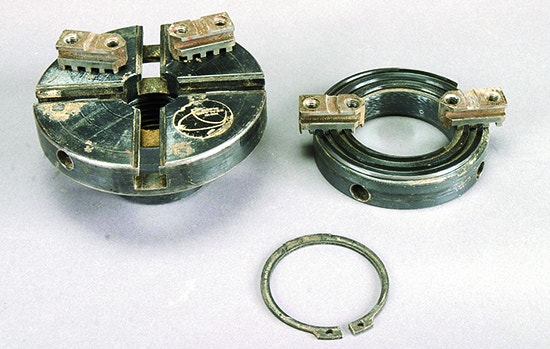Avoiding Chuck Jaw Marks
I recently bought a four-jaw chuck. The chuck itself works great. I want to know how to get rid of the jaw marks that it leaves on the wood. I usually use a face plate to do the outside shape of a bowl and finish the outside. Then I turn it around and use that in the chuck. That is where I begin to have problems. - Mark Welle
Tim Inman: I actually prefer the "smooth" jaws for just the reason you state. If I must use the standard barracuda type jaws, I often put a ring of rubber inner tube or a band of leather between the jaws and the wood. Of course, this means you've given up some of the super holding power of the bare jaw, but my motto is: more skill, less force" in work like this. I do not turn huge bowls.
Betty Scarpino: There are several methods of finish-turning a bowl in a way that do not leave unwanted marks. The various methods depend primarily on the shape of bowl you have turned and the type of equipment you have.
I am assuming, though, that because you have begun the process of turning your bowl with the wood attached to a faceplate, you are using a disc of wood rather than a piece of wood that would result in a natural-edge bowl. Assuming that is the case, then a good solution to removing the jaw marks left on the foot (or tenon) of the bowl would be to remount the bowl again and turn the marks away and sand that area smooth.
One way to accomplish that, without purchasing (or making) additional jaws for your chuck, would be for you to attach a disc of scrap wood (3/4"-thick plywood works well) to your faceplate that is slightly larger in diameter than the rim of your bowl. Use screws that are sufficient to hold the plywood, but don't let them protrude all the way through the plywood. Make sure that piece of plywood is trued up. After it is trued up, place your turned bowl upside down onto the plywood disc, making sure it is centered on the disc.
There are two ways to ensure that your bowl is centered: 1) draw a few circles on the plywood that are approximately the same diameter as the rim of your bowl. Do this with the lathe running and use a pencil. Center your bowl inside one of the circles. Or 2) turn a shallow groove into the plywood that is approximately the diameter of the rim of your bowl, then place the rim of your bowl into that groove. Do not make a jam-fit tightness – you only need to center the bowl. Turning a groove generally results in the most accurate remount of a bowl. A groove also provides a bit more holding power.
When your bowl is centered onto plywood disc, bring up the tailstock to hold the bowl in place. Apply enough pressure to hold the bowl in place, but not so much pressure that you inadvertently crack the bowl. You will now be able to turn away the jaw marks on the tenon. Make sure your lathe is running at a fairly slow speed and take light cuts. Depending on the center that is in your tailstock, you could end up with a small dimple in the center of your bowl. To avoid a dimple, simply put a piece of cardboard or a scrap of wood between the point and your bowl.
If, for some reason your bowl has warped slightly out of round and is not resting evenly on the plywood, then you can shim the sides with strips of masking tape underneath the gaps, making sure to add strips evenly on both sides.
If you are concerned that your bowl might fly off the lathe or if you think that you need additional insurance to hold the bowl onto the plywood, you can add masking tape. Wrap the tape around the bottom of the bowl and attach it to the plywood disc.
Good luck with your bowls and make sure you are wearing sufficient eye, face, hearing, and dust protection!
Keep the inspiration coming!
Subscribe to our newsletter for more woodworking tips and tricks





